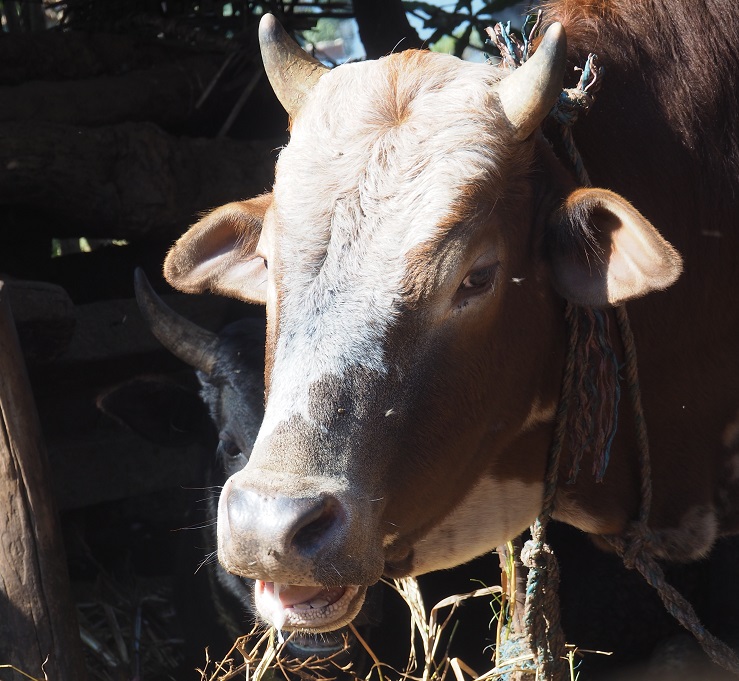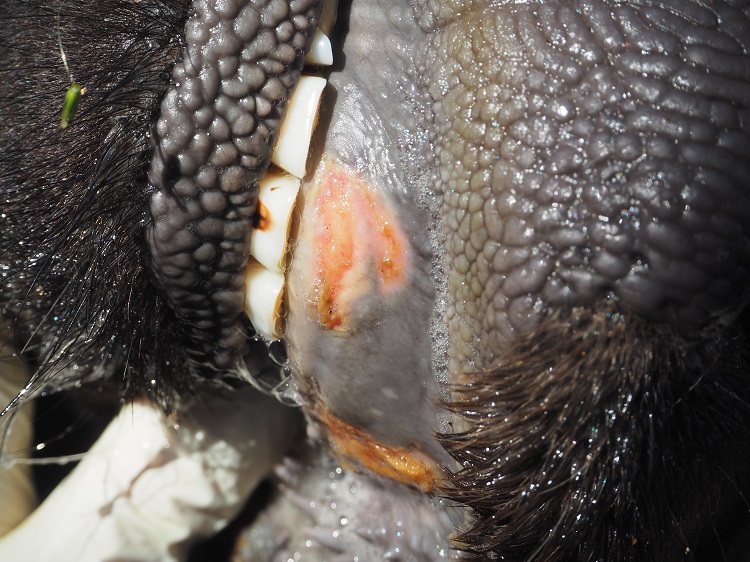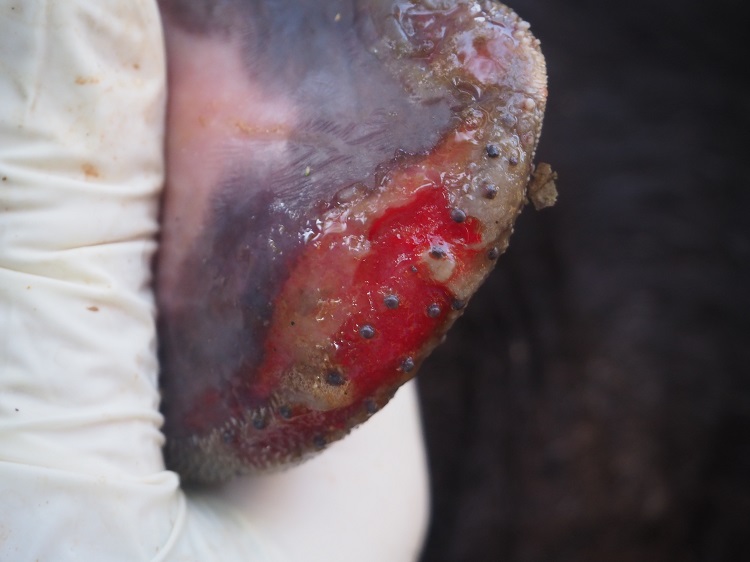FMD (Foot and Mouth Disease)
Highly contagious virus disease of cloven-hoofed animals with serious production losses.
Introduction
It is a highly contagious virus disease of animals. It is one of the most serious livestock diseases. It affects cloven-hoofed animals (those with divided hoofs), including cattle, buffalo, camels, sheep, goats, deer and pigs. It can cause serious production losses the most significant impact of the disease occurs because of its effect on trade in livestock and livestock products.
The disease is characterised by the formation of vesicles and erosions inside the mouth, and on the nose, teats and feet. Mortality is low in adult animals, but deaths can be common in young piglets, calves and lambs.Introduction
There are seven serotypes of the virus: A, O, C, SAT1, SAT2, SAT3 and Asia1. These are further subdivided into more than 60 strains. The importance of these serotypes is that protection against one serotype (e.g. through vaccination) will not protect against infection with another serotype. Different serotypes dominate in different parts of the world.
 |
 |
 |
The Virus
The FMD virus is a small non-enveloped RNA virus. (Family Picornaviridae, genus Aphthovirus) and being non-enveloped means that the virus is able to survive moderately well in the environment, and hence can be transmitted on fomites.
The virus is susceptible to inactivation at low or high pH, so acid or alkali disinfectants can be effective. The virus survives in lymph nodes and bone marrow at neutral pH, but is destroyed in muscle when pH is less than 6.0, i.e., after rigor mortis. The virus can persist in contaminated fodder and the environment for up to one month, depending on the temperature and pH conditions. RNA viruses show frequent spontaneous mutation. This means that new lineages of the virus frequently emerge, allowing the evolution and origin of strains to be tracked.
Symptoms/Clinical Signs
Symptoms in Cattle and Buffalo
- High Fever
- Depression
- Anorexia
- Lameness
- Salivation
- Vesicles and ruptured lesions on the muzzle, inside the mouth, on feet and teats
- Drop in milk production (if milking)
- Smacking" or "chomping" of the jaw in cattle
FMD in cattle is often severe, with marked depression, anorexia, and possibly recumbancy. In milking cows, a drop in milk production often occurs before the onset of other clinical signs. Salivation can be profuse and affected animals may "chomp" and grind their teeth due to mouth pain.
There may also be sudden death in calves, due to myocarditis, and pregnant cows may abort.Clinical signs of foot and mouth disease
Symptoms in Sheep and Goat
Clinical FMD in sheep and goats is often less severe than in pigs and cattle.
Clinical signs include:
- Depression
- Anorexia
- Lameness
Vesicles may be present on the tongue and dental pad but these are often very small and can be hard to see. On the feet, vesicles are present on the coronary band and may also be present in the interdigital space. However, FMD lesions in sheep, especially on the feet, may be transient and heal rapidly, or may become secondarily infected with other pathogens which may complicate diagnosis.
There may be sudden death in lambs due to myocarditis and abortions in ewes. Because FMD in sheep can often be very mild, they can be thought of as "silent shedders", transmitting the disease without showing obvious clinical signs.
Clinical signs of FMD in pigs include
- Fever
- Depression
- Anorexia
- Lameness or reluctance to stand
- Vesicles or ruptured lesions on the snout, inside the mouth and on the feet.
FMD in pigs is usually severe, with pigs reluctant to stand and squealing in pain if they are made to walk. Some pigs may sit in a "dog sitting" position.
The entire claw may detach, known as "thimbling"
Sudden deaths can occur in piglets, due to myocarditis. Lesions are most obvious on the feet, where they form on the coronary band, and also on the heel bulb or in the interdigital cleft. Vesicles may be apparent on the snout. Vesicles may also be present on the tongue, although these can be hard to see in the live animal.
Transmission
FMD is a highly contagious, acute viral disease that spreads rapidly between animals. Virus is excreted in breath, saliva, mucus, milk and faces. The virus can be excreted by animals for up to 4 days before clinical signs appear. Animals can become infected through inhalation, ingestion and direct contact. The disease spreads most commonly through the movement of infected animals. In sheep the symptoms can be absent or very mild, and undetected infected sheep can be an important source of infection. FMD virus can also be spread on wool, hair, grass or straw; by the wind; or by mud or manure sticking to footwear, clothing, livestock equipment or vehicle tires.
Pigs are regarded as ‘amplifying hosts’ because they can excrete very large quantities of the virus in their exhaled breath. Cattle are very susceptible to, and able to be infected by breathing in small quantities of the virus. In some animals (‘carriers’), the virus can continue to be carried for long periods (months or years) after apparent recovery.
Incubation period
The incubation period represents the time from infection (virus enters the animal) to the onset of clinical signs of disease in that animal. Incubation period can range from 2-14 days (although in some circumstances the incubation period can be as short as one day)
The incubation period of FMD is most likely to be 2-5 days, In some circumstances, (experimental inoculation or pigs infected with a pig adapted strain of FMD in highly contaminated pens) the incubation period can be as short as one day
The incubation period of FMD is highly variable and depends on pathogen dose: a higher dose is likely to lead to a shorter incubation period.
The incubation period is also affected by:
- Virus strain
- Species
- Pre-existing immunity
- Physiological status
- Route of Transmission
Source: https://eufmd.rvc.ac.uk
Virus excretion
Virus excretion can begin up to two days prior to or at the appearance of clinical signs, but virus can be detected experimentally in milk up to 4 days before the appearance of clinical signs. Virus excretion usually ceases about 4-5 days after the appearance of vesicles, except in the esophageal-pharyngeal fluid. (Cessation of virus excretion is co-incident with the development of an antibody response which beings to clear the virus) (Alexandersen et al, 2003, Charleston et al, 2011).
Large quantities of virus are released in expired air, particularly in pigs. An infectious pig can produce up to 400 million infectious doses (TCID50) per day, ruminants excrete a maximum of 120,000 infectious doses per day. (Alexandersen, et al, 2003)
For this reason, pigs are seen as important amplifiers of FMD, with the potential to produce vast quantities of airborne virus (AUSVETPLAN, 2014).
Virus is present in fluid from ruptured vesicles and in almost all secretions and excretions including serum, oral and pharyngeal fluid, urine, faeces, semen and milk. It can also be detected in bone marrow and lymph nodes of carcass meat.
Immunity
Immunity to FMD is primarily antibody mediated. Antibodies begin to be detected by ELISA 3-5 days after first appearance of clinical signs, and high levels of antibodies are reached 2-4 days later (5-9 days after the appearance of clinical signs).
The antibody titre remains high after infection, and is detectable for several years in ruminants. In contrast, antibodies may only be detectable for a few months in pigs, especially fast growing young animals. (Alexandersen, et al, 2003)
From Vaccination
A single dose of high-potency vaccine can stimulate immunity as early as 4-6 days. By 21 days post vaccination peak immune response and optimal protection is achieved. Duration of vaccination-induced immunity is short; usually no longer than 6 months (Cox S. and Barnett P., 2009)
FMD Carrier Animals
FMD virus elicits a rapid antibody response and this is sufficient to quickly clear virus from most sites. In ruminants (but not in pigs) FMD virus can persist up to 28 days and beyond in the oropharynx. Up to 50% of ruminant animals become persistently infected after clinical recovery, and this occurs irrespective of the immune status of the animal and often without clinical signs.
The term 'carriers' is used to refer to ruminants in which virus can be intermittently isolated from the oropharyngeal area more than 28 days after infection.
Length of persistence:
Cattle: up to 12 months, some reports suggest up to 3.5 years, Sheep: up to 9 months, African buffalo: at least 5 years
Virus excretion is intermittent, low level and declines over time.
Prevention/Vaccination
Prevention Measures
- Export restrictions, quarantines and movement restrictions
- Euthanasia of affected and in-contact animals, and cleansing and disinfection of affected premises, equipment and vehicles.
- Killing of Rodents and other vectors mechanically
- Good biosecurity measures on farms
-
Vaccination: Vaccination can be used in endemic regions to reduce the spread of FMD or protect specific animals. Vaccines must closely match the serotype and strain of the infecting strain.
Vaccination with one serotype does not protect the animal against other serotypes, and may not protect the animal completely or at all from other strains of the same serotype. Currently, there is no universal FMD vaccine.
FMD vaccines are killed or inactivated vaccines and may be oil or aqueous based. The vaccines also contain an adjuvant in order to stimulate the immune response.
FMD vaccination can:
-
- protect against clinical signs of disease
- reduce likelihood of infection if exposed
- reduce virus shedding if animals are infected
Importantly, however, vaccination does not always prevent infection. Vaccinated animals can be sub-clinically and/or persistently infected.
-

